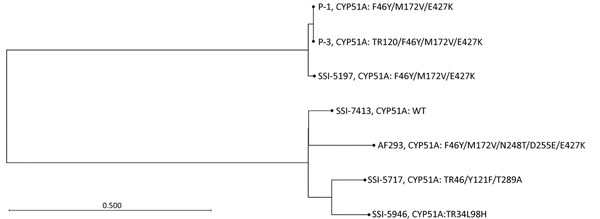Volume 25, Number 3—March 2019
Dispatch
In Vivo Selection of a Unique Tandem Repeat Mediated Azole Resistance Mechanism (TR120) in Aspergillus fumigatus cyp51A, Denmark
Figure 2

Figure 2. Unrooted phylogenetic tree based on whole-genome sequencing of 2 patient isolates (P-1 and P-3) and 5 reference strains to highlight relatedness between Aspergillus fumigatus isolates, Denmark, 2018. We inferred relatedness by using FastTree version 2.1 (7) based on a 77.69% core genome. Whole-genome sequencing identified 41 single-nucleotide polymorphism (SNP) differences between P-1 and P-3. We observed subtle differences (<5,000 SNPs) between unrelated patient isolate SSI-5197 and P-1/P-3, whereas >100,000 SNPs differed from P-1/P-3 to the other control strains and Af293. WT, wild-type.
Page created: February 19, 2019
Page updated: February 19, 2019
Page reviewed: February 19, 2019
The conclusions, findings, and opinions expressed by authors contributing to this journal do not necessarily reflect the official position of the U.S. Department of Health and Human Services, the Public Health Service, the Centers for Disease Control and Prevention, or the authors' affiliated institutions. Use of trade names is for identification only and does not imply endorsement by any of the groups named above.